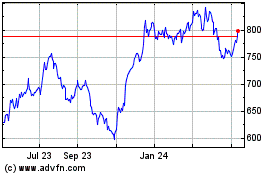By Asjylyn Loder
The amount of money in fixed-income exchange-traded funds passed
$1 trillion last month, an ascendance that has reshaped the market
where countries and companies raise money to pay their bills.
Just 20 years ago, bond ETFs didn't even exist. The bond market
was a largely sleepy enterprise that had long resisted the
high-tech upheaval that transformed the way stocks are bought and
sold. Even today, the biggest bond trades can take hours, or even
days, while billions of dollars in stocks change hands in
seconds.
But from that sleepiness came opportunity.
Firms like BlackRock Inc., Invesco Ltd. and State Street Corp.
put millions behind building a new class of investment: the bond
ETF. The idea was to straddle two disparate markets by wrapping
slow-to-trade bonds in lightning-fast funds. Like a mutual fund,
ETFs bundle together hundreds of bonds into a one-stop-shop ticker.
Unlike mutual funds, ETFs trade all day on a stock exchange just
like shares of Apple Inc. or Bank of America Corp.
Today, the product has never been more popular. All types of
investors -- from pension funds to insurers to retirees -- trade
them daily.
The biggest proponents of bond ETFs say their growth has added
much-needed speed to the sluggish business of bond trading. This
allows investors to move money swiftly when market sentiment
turns.
Skeptics argue that bond ETFs are a dangerous combination. They
say the product could accelerate a selloff if fleeing investors
flood the debt market with more sell-orders than it can handle.
As this debate continues, bond ETFs just get bigger and bigger.
Even the banks and hedge funds that once viewed them as the
competition are now big customers.
"Two or three years ago, a bank wouldn't take our calls about
fixed-income ETFs," said Bill Ahmuty, head of fixed income for
State Street's SPDR ETF business. "Now they're calling us."
One of the biggest hurdles to creating bond ETFs was the
complexity of the fixed-income market. A single company can have
dozens or even hundreds of outstanding notes, each with different
interest rates, due dates and terms. Many transactions are still
handled by phone and instant messages, and some bonds don't trade
for days, or even months.
Thin trading in some of these notes makes it particularly hard
to figure out what debt is worth in real time, but ETFs must post
the value of their portfolio every 15 seconds.
To make this work, the creators of the first fixed-income ETFs
estimated the value based on other information, like derivatives
prices, interest rates or transactions in similar bonds. Since
BlackRock bought iShares from Barclays PLC in 2009, the company has
devoted even more resources to developing and trading bond
ETFs.
BlackRock today manages about $6.5 trillion, up from $1.3
trillion a decade ago.
Earlier this month, The Wall Street Journal sat down with one of
the biggest beneficiaries of the bond ETF boom: Rob Kapito,
president of BlackRock. When asked about the liquidity-crunch
criticism bond ETFs most often get, Mr. Kapito responded with an
eye roll.
Mr. Kapito made little effort to conceal his derision for
armchair alarmists.
"A lot of your colleagues have been trying to find a fault with
this thing," Mr. Kapito said. "It's a pent-up desire that hasn't
been fulfilled, because it actually works."
Mr. Kapito spent much of his early career trading bonds, as did
BlackRock Chief Executive Larry Fink. Its iShares ETF business was
the first to introduce fixed income ETFs in 2002.
Today, roughly half of the assets in fixed-income ETFs is in
iShares funds. Investors in its U.S. fixed-income ETFs pay more
than $600 million a year in fees, almost 20% of iShares domestic
haul, according to Morningstar estimates.
That is a pittance compared with the potential BlackRock is
banking on. Mr. Kapito points out that ETFs own less than 1% of the
world's debt, leaving more than $100 trillion that has yet to be
repackaged into ETFs. It took 17 years to raise the first $1
trillion, but BlackRock predicts fixed-income ETFs will double in
size within the next five years.
"We believe that this is going to be a huge growth area for the
firm," Mr. Kapito said.
Even so, critics remain concerned that the growth of
fixed-income ETFs could distort bond pricing.
Caitlin Dannhauser, an assistant professor of finance at
Villanova University, says her research found that bonds that are
more exposed to an ETF exodus take a bigger hit during bouts of
turbulence than those that aren't. Battered bond prices could make
it harder and more expensive for firms to borrow money.
"It could be really disruptive for a company that has a lot of
bonds exposed to ETF outflows," Ms. Dannhauser said.
Those fears haven't slowed the growth of the industry.
Fixed-income ETFs raised almost $33 billion in June, on track for
their best month in history.
The ETFs are especially popular when there is fast-moving market
news, and bond trading is too slow to keep up. Earlier this month,
when the Federal Reserve hinted that it would lower interest rates
later this year, the oldest iShares corporate-debt ETF had one of
its busiest trading days on record, with more than $3 billion
changing hands.
To receive our Markets newsletter every morning in your inbox,
click here.
Write to Asjylyn Loder at asjylyn.loder@wsj.com
(END) Dow Jones Newswires
July 01, 2019 09:21 ET (13:21 GMT)
Copyright (c) 2019 Dow Jones & Company, Inc.
BlackRock (NYSE:BLK)
Historical Stock Chart
From Mar 2024 to Apr 2024

BlackRock (NYSE:BLK)
Historical Stock Chart
From Apr 2023 to Apr 2024
